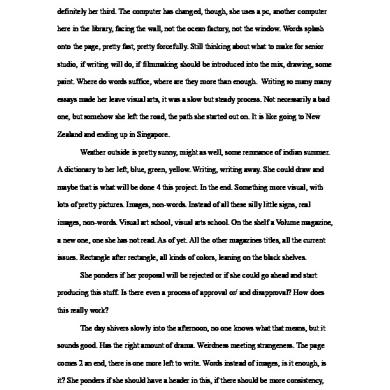Elp.work 9.editing 2
This document was uploaded by user and they confirmed that they have the permission to share it. If you are author or own the copyright of this book, please report to us by using this DMCA report form. Report DMCA
Overview
Download & View Elp.work 9.editing 2 as PDF for free.
More details
- Words: 318
- Pages: 1
Editing Checklist Name of Author_______________________ Name of Peer Editor_________________________ Beginning the peer editing process: Author reads paper aloud to peer editor, making any corrections she/he discovers by hand on the paper. Peer editor listens (does not read along), making notes of any general impressions. After listening to the paper, the editor receives a hard copy of the paper and reads it twice—once for content and once for mechanics. Content Analysis You, as the editor, are to write a critique of your partner’s paper. The critique needs to include the following: 1. Describe what you think is the author’s main point. Underline and example. 2. Describe how the paper hangs to together as a whole. 3. Evaluate the paper, paragraph by paragraph, in terms of flow, transitions, structure and content. 4. Evaluate the flow sentence by sentence. Specifically recommend any changes in sentence structure to improve clarity and conciseness. 5. How focused does the author stay on the main point throughout the piece? Give an example of tight focus, and an example of an unfocused part. 6. Describe the conclusion. Does it bring the reader full circle? If not, suggest how the author might approach it. 7. Cite at least two specific points the author did well. Give examples. 8. Point out at least two specific points the author needs to work on. Give examples. Mechanics Use the following checklist to determine the writing’s strengths and weaknesses in terms of grammar, word usage, structure, etc. Mark any mechanical problems on the paper as well as providing specific written comments. Mark various elements (+ or -) and make comments: Spelling:
Sentence Structure:
Use of apostrophes: Consistent Verb tenses:
Sentence Length: Paragraph Length:
Consistent subject/verb/direct object agreement:
Correct punctuation of quotes: Correct format of attributions (at end of quote, not at beginning.)
Compound words: Word Usage:
Active voice:
Bibliography (format, appropriateness of sources, etc.)
Capitalization: Comma Use:
Other elements
Sentence Structure:
Use of apostrophes: Consistent Verb tenses:
Sentence Length: Paragraph Length:
Consistent subject/verb/direct object agreement:
Correct punctuation of quotes: Correct format of attributions (at end of quote, not at beginning.)
Compound words: Word Usage:
Active voice:
Bibliography (format, appropriateness of sources, etc.)
Capitalization: Comma Use:
Other elements
Related Documents

Seniorstudio 2(2)(2)
June 2020 80
Seniorstudio 2(2)(2)
June 2020 86
Seniorstudio 2(2)(2)
June 2020 77
2-2
November 2019 81
2-2
May 2020 54